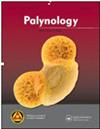A Review of Pollen Types Foraged By Melipona in the Brazilian Amazon
IF 1.3
4区 地球科学
Q3 PALEONTOLOGY
引用次数: 2
Abstract
ABSTRACT Bees of the genus Melipona found in the Amazon are investigated given their ecological, sociocultural and economic importance. The objective of this work was to analyze the scientific literature to recognize patterns in the richness of pollen types foraged by Melipona, comparing four methodological approaches. In the literature review, two databases were consulted: Web of Science (WoS) and the Scientific Electronic Library Online (SciELO). A record of 18 Melipona species investigated in 23 studies was found. These foraged 498 pollen types distributed in 88 botanical families. Many factors affect this richness. The main factor is the sampling time, which can influence other decisions. The highest richness estimates were found in the 12 month studies. The differences between the vegetation types reflect the patterns of diversity naturally found between them. Material from the meliponaries and bee corbels will result in a greater diversity of pollen types. Although there has been an increase in Melipona studies in the Amazon more effort is needed to fill the gaps in this vast territory.巴西亚马逊河蜜梨属植物采食花粉类型研究进展
摘要:研究了亚马逊河流域蜜蜂属的生态、社会文化和经济重要性。本研究的目的是分析科学文献,以识别蜜梨草采集花粉类型丰富度的规律,并比较四种方法。在文献综述中,参考了两个数据库:Web of Science (WoS)和Science Electronic Library Online (SciELO)。在23项研究中发现了18种貂鱼的记录。这498种花粉类型分布在88个植物科。影响这种丰富性的因素很多。主要因素是采样时间,它会影响其他决策。在12个月的研究中发现了最高的丰富度估计值。植被类型之间的差异反映了它们之间自然存在的多样性格局。来自蜂冠和蜂冠的物质将导致花粉类型的更大多样性。尽管在亚马逊地区进行的梅利波纳研究有所增加,但要填补这片广袤土地上的空白,还需要付出更多的努力。
本文章由计算机程序翻译,如有差异,请以英文原文为准。
求助全文
约1分钟内获得全文
求助全文
来源期刊

Palynology
地学-古生物学
CiteScore
3.40
自引率
26.70%
发文量
48
审稿时长
>12 weeks
期刊介绍:
Palynology is an international journal, and covers all aspects of the science. We accept papers on both pre-Quaternary and Quaternary palynology and palaeobotany. Contributions on novel uses of palynology, review articles, book reviews, taxonomic studies and papers on methodology are all actively encouraged.
 求助内容:
求助内容: 应助结果提醒方式:
应助结果提醒方式:


